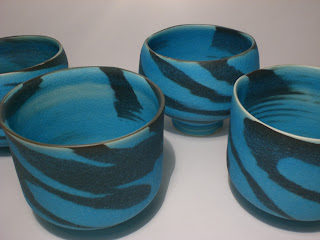
I know I have mentioned my need to understand and even master the art of being patient. It would seem to be that patience is as much a part of any craft as is technique and technology and in a way, of far more value. As a beginning potter, I had less than zero patience and I find now 20 years later, though I am certainly far more patient than I was, it is never enough and in somewhat short supply. When you think about it, we all probably wait away a third of our lives and another third sleeping. This is not to say that while waiting, valuable pursuits are not achieved.
Last week, my patience wore thread bare waiting on pots to dry and to get a bisque fired. Today, I am at the upper temperature range of a glaze firing and as I find myself checking the kiln every 10 minutes or so, I realize, I am no more patient than I was many years ago. I am sure once the kiln is off, I will try to tear down what remains of my pottery patience waiting to crack open the kiln and get the pots unloaded. As the quote goes; “endurance is patience concentrated………………..”
Last week, my patience wore thread bare waiting on pots to dry and to get a bisque fired. Today, I am at the upper temperature range of a glaze firing and as I find myself checking the kiln every 10 minutes or so, I realize, I am no more patient than I was many years ago. I am sure once the kiln is off, I will try to tear down what remains of my pottery patience waiting to crack open the kiln and get the pots unloaded. As the quote goes; “endurance is patience concentrated………………..”















